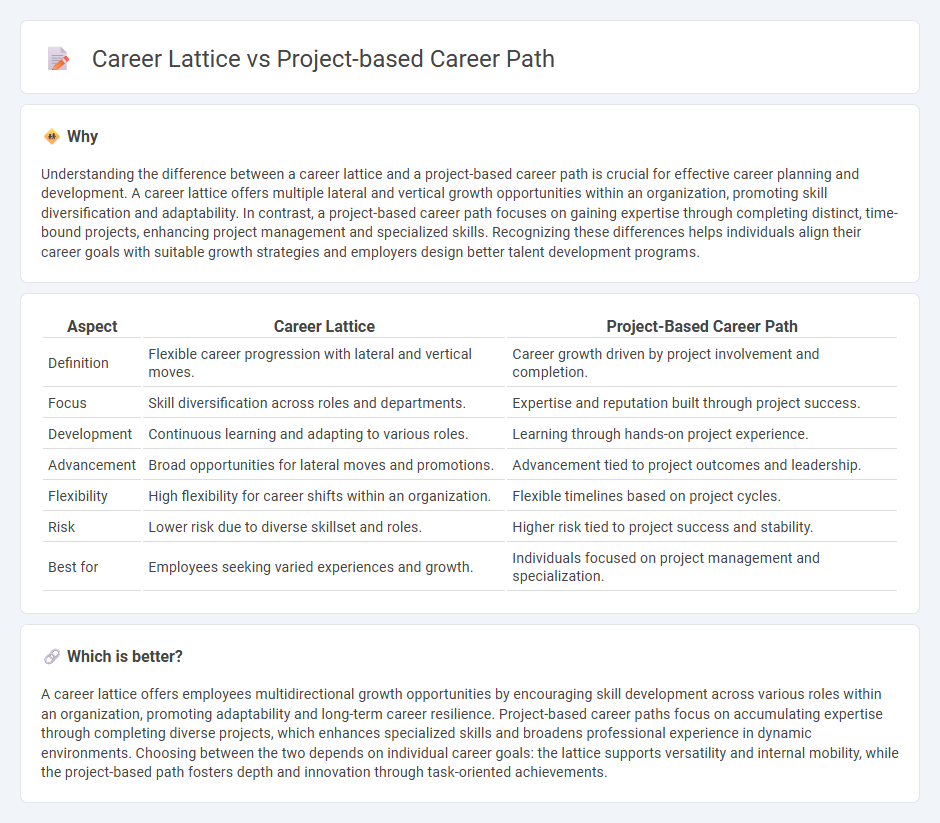
Employment strategies vary between career lattice and project-based career path models, each offering unique advancement opportunities. Career lattice encourages lateral moves and skill diversification within an organization, fostering long-term growth and adaptability. Explore more to determine which path aligns with your professional goals and work style.
Why it is important
Understanding the difference between a career lattice and a project-based career path is crucial for effective career planning and development. A career lattice offers multiple lateral and vertical growth opportunities within an organization, promoting skill diversification and adaptability. In contrast, a project-based career path focuses on gaining expertise through completing distinct, time-bound projects, enhancing project management and specialized skills. Recognizing these differences helps individuals align their career goals with suitable growth strategies and employers design better talent development programs.
Comparison Table
| Aspect | Career Lattice | Project-Based Career Path |
|---|---|---|
| Definition | Flexible career progression with lateral and vertical moves. | Career growth driven by project involvement and completion. |
| Focus | Skill diversification across roles and departments. | Expertise and reputation built through project success. |
| Development | Continuous learning and adapting to various roles. | Learning through hands-on project experience. |
| Advancement | Broad opportunities for lateral moves and promotions. | Advancement tied to project outcomes and leadership. |
| Flexibility | High flexibility for career shifts within an organization. | Flexible timelines based on project cycles. |
| Risk | Lower risk due to diverse skillset and roles. | Higher risk tied to project success and stability. |
| Best for | Employees seeking varied experiences and growth. | Individuals focused on project management and specialization. |
Which is better?
A career lattice offers employees multidirectional growth opportunities by encouraging skill development across various roles within an organization, promoting adaptability and long-term career resilience. Project-based career paths focus on accumulating expertise through completing diverse projects, which enhances specialized skills and broadens professional experience in dynamic environments. Choosing between the two depends on individual career goals: the lattice supports versatility and internal mobility, while the project-based path fosters depth and innovation through task-oriented achievements.
Connection
Career lattice and project-based career path both emphasize lateral and experiential growth within an organization, allowing employees to develop diverse skills through cross-functional projects. The career lattice supports varied role transitions, while project-based paths focus on accumulating project experiences that demonstrate adaptability and expertise. Together, they create flexible career development routes that align with dynamic workplace demands and individual aspirations.
Key Terms
Flexibility
A project-based career path emphasizes completing specific assignments with measurable outcomes, allowing professionals to develop specialized skills and demonstrate adaptability across varied projects. A career lattice promotes flexibility by encouraging lateral moves, skill diversification, and role changes within an organization rather than a linear progression. Explore how these models enhance workforce agility and personal growth strategies.
Skill diversification
Project-based career paths emphasize acquiring expertise through sequential project experiences, fostering deep proficiency in specific skills. Career lattices promote horizontal movement across roles, encouraging skill diversification and adaptability by developing a broader range of competencies. Explore how each approach can enhance your professional growth and skillset.
Advancement routes
Project-based career paths emphasize skill acquisition and expertise through diverse, time-bound assignments, fostering vertical advancement within specific roles or functions. Career lattices offer multidirectional growth opportunities, encouraging lateral moves that broaden competencies and enhance adaptability across departments. Explore these strategies to identify the best advancement route tailored to your professional goals.
Source and External Links
Project Manager Career Path: From Entry-Level to VP - This article outlines how to start a career in project management by gaining fundamental skills, entering entry-level roles, and progressing into management positions with good salary prospects and industry versatility.
Building a Career Path as a Project Manager | IPM - Discusses a strategic approach to building a project-based career path starting with entry-level supporting roles, certifications like CAPM and Agile, volunteer opportunities, freelance projects, and shadowing experienced project managers for hands-on learning.
The Pros and Cons of Project-Based Employment - Explains project-based employment where individuals are hired for specific short-term projects with defined goals, highlighting flexibility and disruption of the traditional work model, often used by freelancers and contractors especially in IT industries.
 dowidth.com
dowidth.com